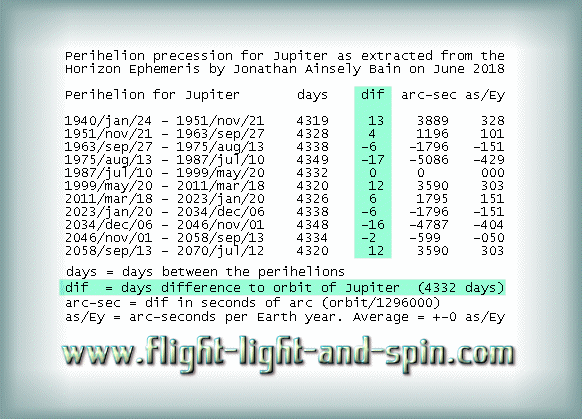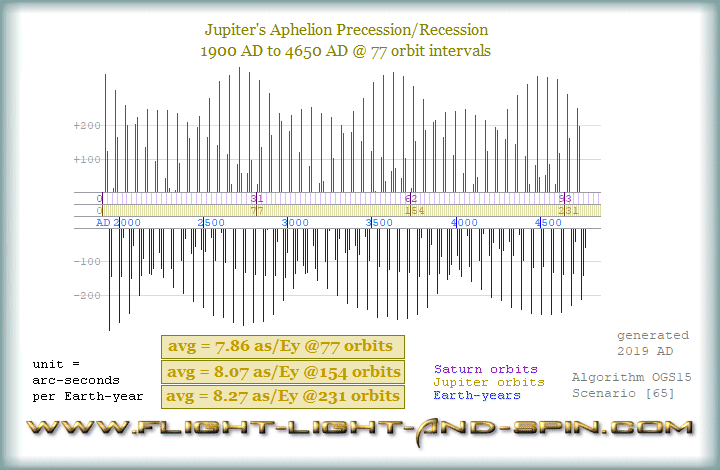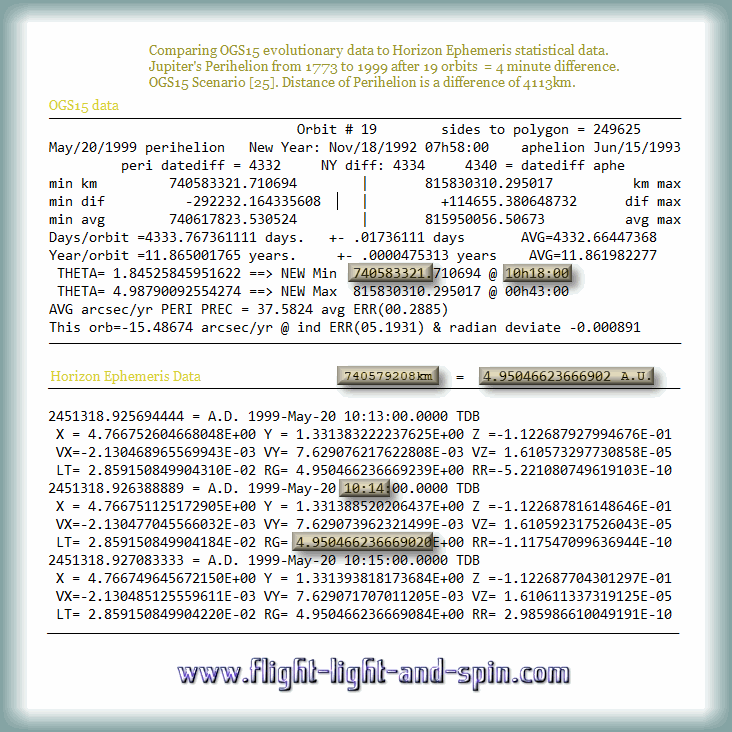That
NASA's error-margins are greater than my own is realized when
we consider the question of the average duration of Jupiter's
orbit. This is given by the NASA fact sheet as being 4332.589
days or 11.86177 years.
https://nssdc.gsfc.nasa.gov/planetary/factsheet/jupiterfact.html
But
with individual Perihelions varying by as much as a month
different from the average orbital duration, (see extract
at top of page) it is vital to know which orbits in particular
are being averaged, when offering amounts of such precise
decimals with claims to within a single minute of time. Because
the crucial sample size and detail information is just not
offered, I had to try a variety of samples when using the
starting point of perihelion for Jupiter of 18
December 1773 @ 12h53.
Scenario [29]
and Scenario [20]
of the OGS15 algorithm evolve an average
orbit of the given 11.86177 years over 77
orbits and 20 orbits respectively.
Both scenarios are then evolved to the 1999
perihelion for Jupiter.
Now Horizon Ephemeris had given the date for the 1999
perihelion as May 20th.
But the scenario that uses the 20 orbit average
gave that date as early on May 19th.
Whereas the 77 orbit average gave that perihelion
taking place on May 22nd.
So the 77 orbit average of 11.86177
years will require those first 20 orbits
of Jupiter to yield a higher average of 11.86228
years, see?
Now it seems to me that with the orbit fluctuating so much,
that the observation of the perihelion date of 20th
May 1999 should be the benchmark to aim at. I selected
that date because it was widely confirmed as having been observed
as Jupiter's perihelion by numerous websites. This historical
'fact' should be confirmed after 20 years
of corroboration.
And in order for the algorithm to split the difference and
arrive at Jupiter's perihelion on the given date of 20th
May 1999, this can only give a 20
orbit average of 11.861917
years, which is 4332.640 days. (Not
4332.589). So that's a discrepancy of about
1 hour over 237 years.
Now its hardly meaningful to go back in time further than
237 years of observation as that amount represents
a fair portion since the discovery of Uranus, and also fits
with the optimal amount of 8 orbits for Saturn,
Jupiter's most significant partner. This is fairly close to
3 orbits of Uranus, and thus this is the
only meaningful sample size for an average duration for Jupiter's
orbit.
But another fact sheet of NASA:
https://nssdc.gsfc.nasa.gov/planetary/factsheet/index.html
gives Jupiter a 4331 day orbit, which is
11.857 years,
whereas the Horizon Ephemeris is happy with 11.862615
https://ssd.jpl.nasa.gov/?planet_phys_par
My own value fits the given observational date of 20
May 1999 perihelion with an amount in between those
two values, so I have to conclude that my algorithm is most
accurate at 11.8619179
years for Jupiter's orbit. Thus all my other scenarios
starting 1773 therefore use this more accurate
value.
Now the difference between those two NASA values is close
to 2 days, whereas my algorithm can happily
reconcile with the observational data to within 4
minutes. This takes my little laptop 10 hours
to compute a quantity of 237 years.
Scenario [39]
and Scenario [30]
do the same computation as Scenario [29]
and Scenario [20]
with 10 times better accuracy. But I have
never run them due to Windows 10 being a
fairly tragic clone 10 times slower than
the older more efficient operating systems like good old Windows
XP.
Despite this setback, my computational processes seem to quite
happily keep up with, and even out-perform all the super-computers
at NASA. The formulae I derived for this study on 3d-n-body-gravity
is free on this page: N-body-gravity
Algorithm. This is of course due to logical positivist
methodology.
So once more I say: If you are not building your own 3d-n-body-gravity-algorithm,
then you have no right to claim a bona fide understanding
of gravity, the scientific method, Newton, or poor old tragic,
Albert Einstein. Though he is not as tragic as those that
follow his pseudo-science so blindly. As it is, the previous
algorithm OGS12 demonstrated that Jupiter
should move away from the sun at 800km per
orbit if gravity between Sun and Jupiter was delayed to move
at the speed of light.
See link: www.flight-light-and-spin.com/simulator/relativity-jupiter.htm
Of course that would make the solar system have to be radically
younger than all geological samples suggest. And yet with
gravity calculated as instant, all Einstein's formulae given
the boot, the result was this accurate:




